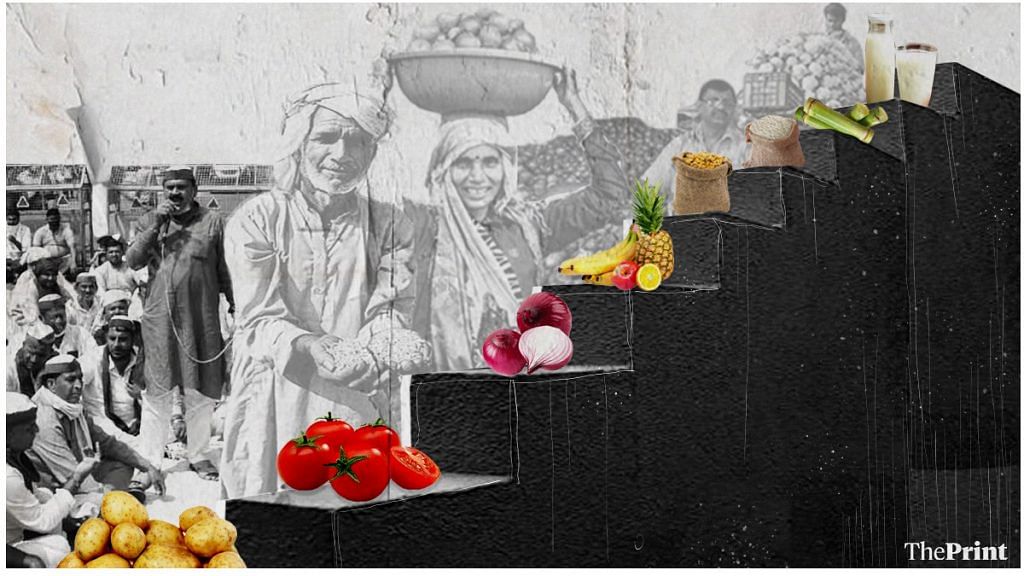There are two ways to increase a farmer’s income. One is through higher productivity. The other is higher prices. The only way to get higher prices without hitting the consumer is by increasing the farmer’s share of the retail price. There are three ways of doing that: The government offers a minimum price guarantee (as with foodgrain) along with a price subsidy, or it mandates a minimum price (e.g. for sugarcane) that bulk customers (sugar mills) have to pay. The third option is for farmers to organise themselves as cooperatives, cut out middlemen, and/or capture greater value by processing the raw output. The best example is milk cooperatives. The global success stories in cooperative action are California’s Blue Diamond almonds and Norwegian salmon.
In foodgrain, the subsidy allows the farmer to get a price that roughly equals the retail market price. In sugarcane and milk, the farmer’s take is up to 75 per cent. In comparison, the growers of TOPs (tomatoes, onions, and potatoes) and horticulture in general, which have a combined tonnage greater than for foodgrain, get barely 30 per cent of the retail price, on average. The rest goes to a succession of middlemen. Direct marketing efforts can take this up to 40 per cent. There are also crops where growers get as little as 10 per cent of the retail price, as experienced with coffee and bananas (both in Latin America, where O. Henry coined the term “banana republic” to describe what he saw).
These varying percentages create a price bias towards the crops where the farmer’s share of the take is greater. Sugarcane and paddy have become profitable, so farmers grow them in even water-scarce areas. India has a surplus of both, as also milk. For sensible crop choices, it is important that the grower’s share is improved in other crops. Can that be done, without a government subsidy or price intervention? Yes. For even if the share does not match cane or milk, direct marketing initiatives offer big potential benefits. So the debate has to go beyond the binaries being spun out by politicians who either condemn the new farm Bills, or think the new system will be the agricultural equivalent of the 1991 de-licencing of industry. It’s not so one-sided, or so simple.
Also read: When Modi govt came to power, farmer protests increased 700% — the 3 bills are its result
The history of regulated markets, potentially a victim of the new enactments, is instructive. The first such market, for cotton, was created in 1897, so that textile mills in Manchester could get pure cotton from India. From then till nearly a century later, regulated markets multiplied to over 8,000 because they offered standard weights, the grading of produce, transparent pricing, and so on. They fell into bad odour because poor management practices set in: Control by vested interests, price manipulation, excessive fees and taxes, and exploitation of small farmers.
Small coffee growers in south India improved their price realisation when they rebelled against the exploitative trading rules of the Coffee Board in the 1980s. But permission to by-pass auction centres for tea had the opposite result. The lesson is what the Nobel laureate Elinor Ostrom (who favoured collective action by people, and not governments taking charge of common resources) argued: A resource arrangement that works in practice can work in theory!
The government has gone for theory, which is that the farmer should be free to sell to whoever he chooses, wherever he chooses, whenever he chooses. But what freedom does a small farmer really have when up against large food processors or retail chains that buy in bulk? Freedom is enjoyed by those who have market power, or so says another theory. But have potato farmers complained about Pepsi? And the orange growers’ association has sought help from the Safal chain to sell oranges in the pandemic. The fact is that outcomes vary across crops, over time, and in different geographies. So farmers producing some crops in some states are protesting, not others.
The real hope lies in the farmer producer organisations being pushed by the government — if these get off the ground in the right way and acquire scale. For that, the hard work lies ahead. And then there’s the question no one discusses: Productivity.
By Special Arrangement with Business Standard.
Also read: Modi’s farm bills gamble is risky, but it was about time and is still worth it
